Geopolymers Based on a Mixture of Steel Slag and Fly Ash, Activated with Rice Husks and Reinforced with Guadua angustifolia Fibers
Abstract
:1. Introduction
2. Materials and Methods
2.1. Materials
2.2. Alkali Activation of the Mixtures
2.3. Techniques
2.4. Tensile Strength and Flexural Testing
3. Results and Discussion
4. Conclusions
Author Contributions
Funding
Institutional Review Board Statement
Acknowledgments
Conflicts of Interest
References
- De Sá, F.; Silva, F.; Cardoso, D. Tensile and flexural performance of concrete members reinforced with polypropylene fibers and GFRP bars. Compos. Struct. 2020, 253, 112784. [Google Scholar] [CrossRef]
- Okeil, A.; Matsumoto, K.; Nagai, K. Investigation on local bond behavior in concrete and cement paste around a deformed bar by using DIC technique. Cem Concr Compos 2020, 109, 103540. [Google Scholar] [CrossRef]
- Li, Y.-F.; Hao, G.-W.; Syu, J.-Y.; Chen, B.-Y.; Lee, W.-H.; Tsai, Y.K. Use of Geopolymer and Carbon Fiber-Reinforced Polymer for Repairing Reinforced Concrete Deck Soffit. Materials 2023, 16, 4459. [Google Scholar] [CrossRef] [PubMed]
- Ghavami, K. Bamboo as reinforcement in structural concrete elements. Cem. Concr. Compos. 2005, 27, 637–649. [Google Scholar] [CrossRef]
- Drury, B.; Padfield, C.; Russo, M.; Swygart, L.; Spalton, O.; Froggatt, S.; Mofidi, A. Assessment of the Compression Properties of Different Giant Bamboo Species for Sustainable Construction. Sustainability 2023, 15, 6472. [Google Scholar] [CrossRef]
- Usman-Kankia, M.; Baloo, L.; Danlami, N.; Zawawi, N.A.; Bello, A.; Muhammad, S.I. Microstructural Analysis and Compressive Strength of Fly Ash and Petroleum Sludge Ash Geopolymer Mortar under High Temperatures. Sustainability 2023, 15, 9846. [Google Scholar] [CrossRef]
- ASTM C618-22; Standard Specification for Coal Fly Ash and Raw or Calcined Natural Pozzolan for Use in Concrete. ASTM International: West Conshohocken, PA, USA, 2023.
- Garcia-Lodeiro, I.; Boudissa, N.; Fernandez-Jimenez, A.; Palomo, A. Use of clays in alkaline hybrid cement preparation. The role of bentonites. Mater. Lett. 2018, 233, 134–137. [Google Scholar] [CrossRef]
- Huang, P.; Huang, B.; Li, J.; Wu, N.; Xu, Q. Application of sugar cane bagasse ash as filler in ultra-high-performance concrete. J. Build. Eng. 2023, 71, 106447. [Google Scholar] [CrossRef]
- Yang, Z.; Xiong, X.; Chen, S.; Briseghella, B.; Marano, G.C.; Zhang, Y. Effect of fineness on the hydration and microstructure of cementitious materials with high-volume steel slag and blast furnace slag. J. Build. Eng. 2023, 72, 106682. [Google Scholar] [CrossRef]
- Xu, S.; Yuan, P.; Liu, J.; Pan, Z.; Liu, Z.; Su, Y.; Li, J.; Wu, C. Development and preliminary mix design of ultra-high-performance concrete based on geopolymer. Constr. Build Mater. 2021, 308, 125110. [Google Scholar] [CrossRef]
- Zeng, Q.; Liu, X.; Zhang, Z.; Wei, C.; Xu, C. Synergistic utilization of blast furnace slag with other industrial solid wastes in cement and concrete industry: Synergistic mechanisms, applications, and challenges. Green Energy Environ. 2023, 1, 100012. [Google Scholar] [CrossRef]
- Fernandez, A.; Alonso, M.C.; García-Calvo, J.L.; Lothenbach, B. Influence of the synergy between mineral additions and Portland cement in the physical-mechanical properties of ternary binders. Mater. de Construccion. 2016, 66, 1–12. [Google Scholar] [CrossRef] [Green Version]
- Zhou, A.; Wei, H.; Guo, H.; Zhang, W.; Liu, T.; Zou, D. Mechanical performance and environmental potential of concrete with engineering sediment waste for sustainable built environment. Resour. Recycl. 2023, 189, 106742. [Google Scholar] [CrossRef]
- Afolalu, S.A.; Okwilagwe, O.; Emetere, M.M.; Ikumapayi, O.M. Impact and optimization of a new paradigm in engineering economics for sustainable manufacturing operations. Mater. Today Proc. 2021, 44, 2889–2894. [Google Scholar] [CrossRef]
- Caicedo, J.C.; Ramirez-Malule, H.; Aperador, W. Mechanical properties evolution in carbon foams obtained from Guadua Angustifolia. Diam. Relat. Mater. 2020, 107, 107901. [Google Scholar] [CrossRef]
- Aperador, W.; Mejía de Gutiérrez, R.; Bastidas, D.M. Steel corrosion behaviour in carbonated alkali-activated slag concrete. Corros. Sci. 2009, 51, 2027–2033. [Google Scholar] [CrossRef] [Green Version]
- Montoya, R.; Aperador, W.; Bastidas, D.M. Influence of conductivity on cathodic protection of reinforced alkali-activated slag mortar using the finite element method. Corros. Sci. 2009, 51, 2857–2862. [Google Scholar] [CrossRef] [Green Version]
- Ziejewska, C.; Marczyk, J.; Korniejenko, K.; Bednarz, S.; Sroczyk, P.; Łach, M.; Mikuła, J.; Figiela, B.; Szechyńska-Hebda, M.; Hebda, M. 3D Printing of Concrete-Geopolymer Hybrids. Materials 2022, 15, 2819. [Google Scholar] [CrossRef]
- Su, Q.; Xu, J. Mechanical properties of concrete containing glass sand and rice husk ash. Constr. Build Mater. 2023, 393, 132053. [Google Scholar] [CrossRef]
- Criado, M.; Aperador, W.; Sobrados, I. Microstructural and Mechanical Properties of Alkali Activated Colombian Raw Materials. Materials 2016, 9, 158. [Google Scholar] [CrossRef] [Green Version]
- Lilargem-Rocha, D.; Tambara, J.; Marvila, M.T.; Pereira, E.C.; Souza, D.; De Azevedo, A. A Review of the Use of Natural Fibers in Cement Composites: Concepts, Applications and Brazilian History. Polymers 2022, 14, 2043. [Google Scholar] [CrossRef] [PubMed]
- ASTM C496-96; Standard Test Method for Splitting Tensile Strength of Cylindrical Concrete Specimens. ASTM International: West Conshohocken, PA, USA, 2017.
- ASTM C109/C109M-20; Standard Test Method for Compressive Strength of Hydraulic Cement Mortars. ASTM International: Wets Conshohocken, PA, USA, 2020.
- ASTM C33/C33M-18; Standard Specification for Concrete Aggregates. ASTM International: Philadelphia, PA, USA, 2003.
- ASTM C496/C496M-17; Standard Test Method for Splitting Tensile Strength of Cylindrical Concrete Specimens. ASTM International: Wets Conshohocken, PA, USA, 2017.
- ASTM C78-09; Standard Test Method for Flexural Strength of Concrete. ASTM International: Wets Conshohocken, PA, USA, 2010.
- Sanchez-Echeverri, L.A.; Ganjian, E.; Medina-Perilla, J.A.; Quintana, G.C.; Sanchez-Toro, J.H.; Tyrer, M. Mechanical refining combined with chemical treatment for the processing of Bamboo fibers to produce efficient cement composites. Constr. Build Mater. 2021, 269, 121232. [Google Scholar] [CrossRef]
- Bala, A.; Gupta, S. Engineered bamboo and bamboo-reinforced concrete elements as sustainable building materials: A review. Constr. Build Mater. 2023, 394, 132116. [Google Scholar] [CrossRef]
- Kadivar, M.; Gauss, C.; Mármol, G.; De Sá, A.D.; Fioroni, C.; Ghavami, K.; Savastano, H. The influence of the initial moisture content on densification process of D. asper bamboo: Physical-chemical and bending characterization. Constr. Build Mater. 2019, 229, 116896. [Google Scholar] [CrossRef]
- Libre, R.G.; Leaño, J.L.; Lopez, L.F.; Cacanando, C.J.; Promentilla, M.A.; Ongpeng, J.M. Microstructure and mechanical performance of bamboo fiber reinforced mill-scale—Fly-ash based geopolymer mortars. Chem. Eng. 2023, 6, 100110. [Google Scholar] [CrossRef]
- Hughes, T.L.; Methven, C.M.; Jones, T.G.; Pelham, S.E.; Fletcher, P.; Hall, C. Determining cement composition by Fourier transform infrared spectroscopy. Adv. Cem. Based Mater. 1995, 2, 91–104. [Google Scholar] [CrossRef]
- Mendes dos Santos, V.H.; Pontin, D.; Dias, G.G.; Guimarães, A.S.; Bordulis, R.M.; Kerber, M.K.; Oliveira, S.M.; Dalla, F. Application of Fourier Transform infrared spectroscopy (FTIR) coupled with multivariate regression for calcium carbonate (CaCO3) quantification in cement. Constr. Build Mater. 2021, 313, 125413. [Google Scholar] [CrossRef]
- Uppal, N.; Pappu, A.; Sorna, V.; Thakur, K. Cellulosic fibres-based epoxy composites: From bioresources to a circular economy. Ind. Crops Prod. 2022, 182, 114895. [Google Scholar] [CrossRef]
- Savastano, H.; Santos, S.F.; Fiorelli, J.; Agopyan, V. Sustainable use of vegetable fibres and particles in civil construction. In Woodhead Publishing Series in Civil and Structural Engineering, Sustainability of Construction Materials, 2nd ed.; Khatib, J.M., Ed.; Woodhead Publishing: Sawston, UK, 2016; pp. 477–520. [Google Scholar]
- Perremans, D.; Trujillo, E.; Ivens, J.; Van Vuure, A.W. Effect of discontinuities in bamboo fibre reinforced epoxy composites. Compos. Sci. Technol. 2018, 155, 50–57. [Google Scholar] [CrossRef]
- Fuentes, C.A.; Tran, L.Q.N.; Dupont-Gillain, C.; Vanderlinden, W.; De Feyter, S.; Van Vuure, A.W.; Verpoest, I. Wetting behaviour and surface properties of technical bamboo fibres. Colloids Surf. A Physicochem. Eng. Asp. 2011, 380, 89–99. [Google Scholar] [CrossRef]
- Kelkar, B.U.; Shukla, S.R.; Yadav, S.M. Interlaminar fracture energy and its dependence on microstructure in three bamboo species of commercial importance. Theor. Appl. Mech. 2023, 124, 103824. [Google Scholar] [CrossRef]
- Ishwarya, G.; Singh, B.; Deshwal, S.; Bhattacharyya, S.K. Effect of sodium carbonate/sodium silicate activator on the rheology, geopolymerization and strength of fly ash/slag geopolymer paste. Cem. Concr. Compos. 2019, 97, 226–238. [Google Scholar]
- Chen, Z.; Lu, S.; Tang, M.; Ding, J.; Buekens, A.; Yang, J.; Qiu, Q.; Yan, J. Mechanical activation of fly ash from MSWI for utilization in cementitious materials. Waste Manag. 2019, 88, 182–190. [Google Scholar] [CrossRef]
- Chen, S.; Zeng, W.; Gu, L.; Lin, W.; Wu, B.; Xue, K.; Hsu, H. Effects of combining binary mineral admixtures and manufactured basalt sand on the microscopic properties of mortar. J. Build. Eng. 2023, 66, 105873. [Google Scholar] [CrossRef]
- Yingliang, Z.; Zhengyu, M.; Jingping, Q.; Xiaogang, S.; Xiaowei, G. Experimental study on the utilization of steel slag for cemented ultra-fine tailings backfill. Powder Technol. 2020, 375, 284–291. [Google Scholar] [CrossRef]
- Chen, Z.; Ma, R.; Du, Y.; Wang, X. State-of-the-art review on research and application of original bamboo-based composite components in structural engineering. Structures 2022, 35, 1010–1029. [Google Scholar] [CrossRef]
- Correal, J.F.; Calvo, A.F.; Trujillo, D.; Echeverry, J.S. Inference of mechanical properties and structural grades of bamboo by machine learning methods. Constr. Build Mater. 2022, 354, 129116. [Google Scholar] [CrossRef]
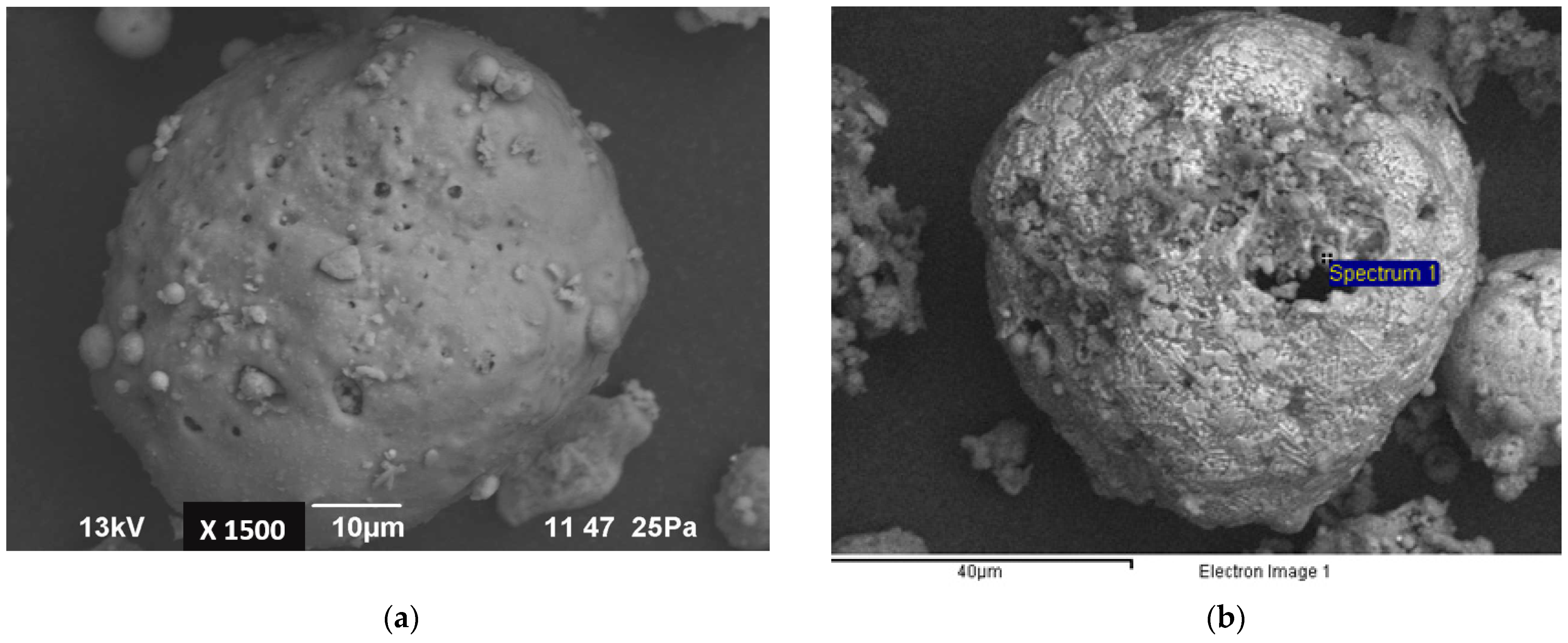
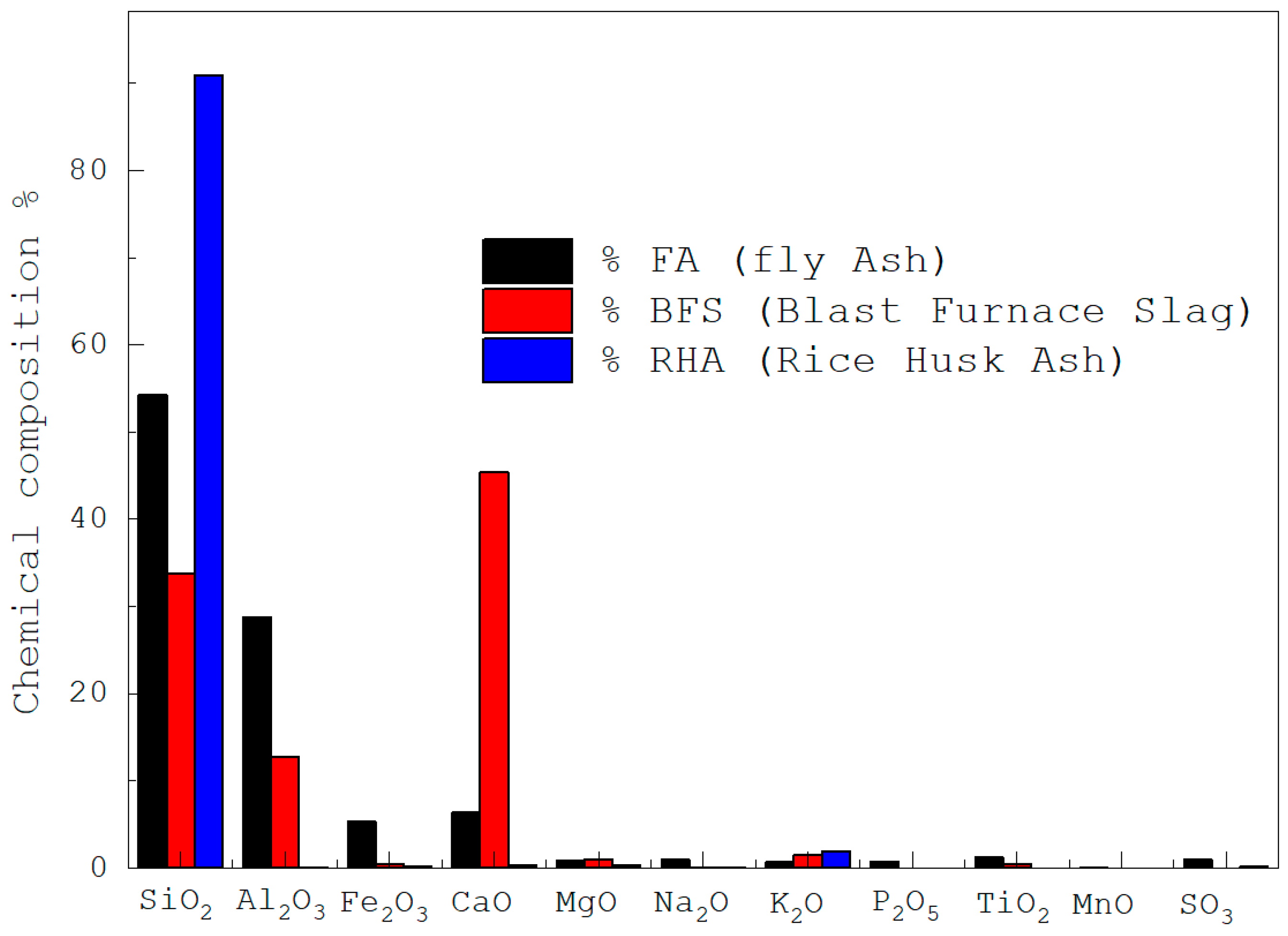


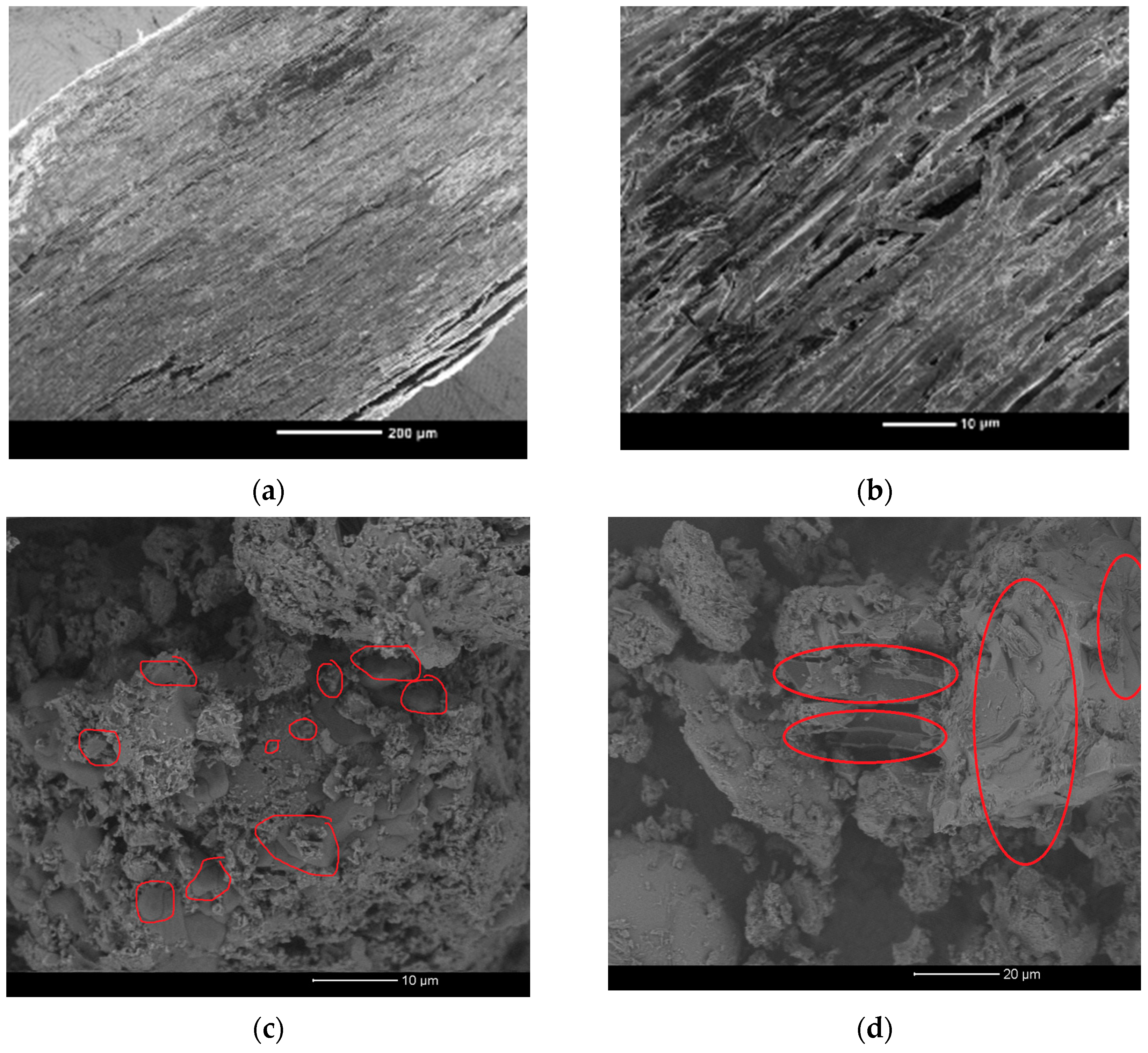
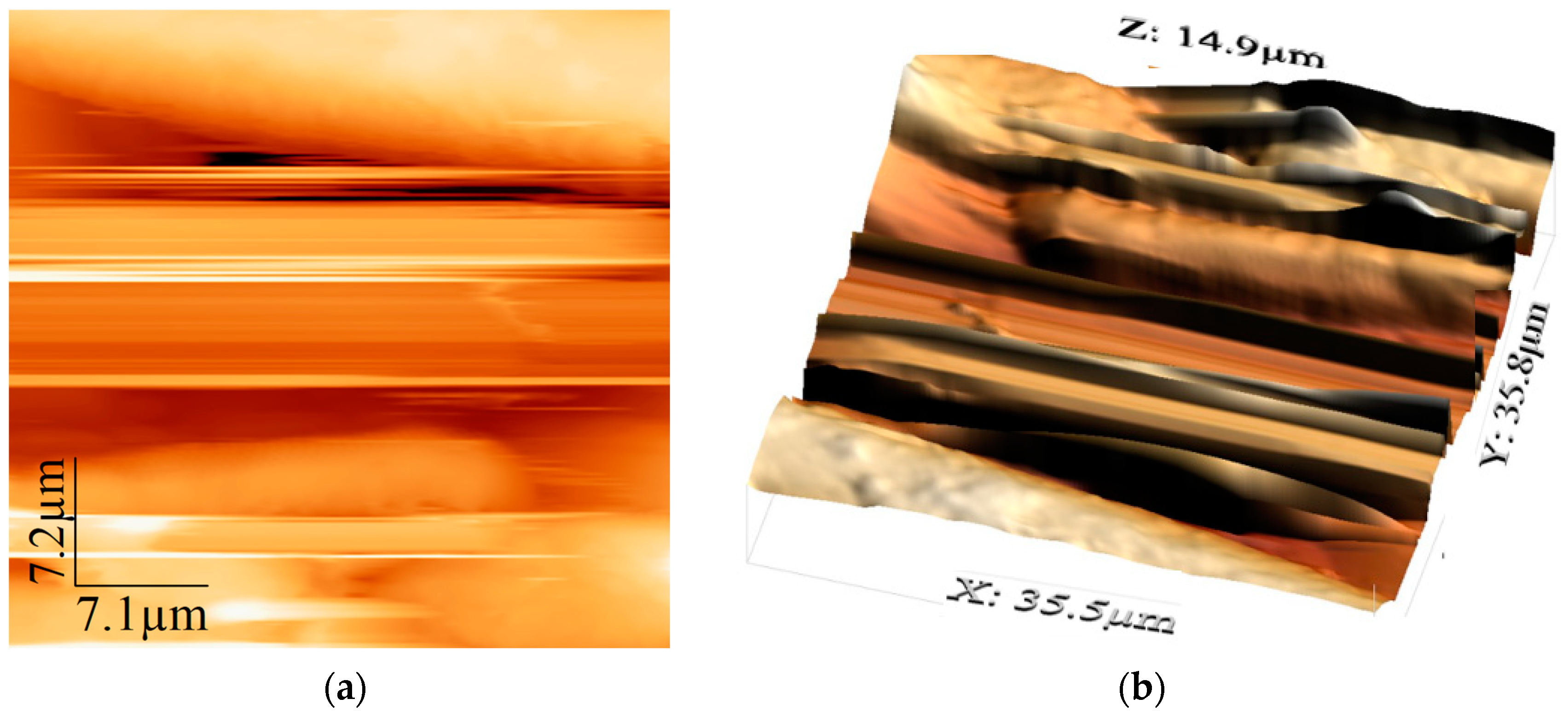
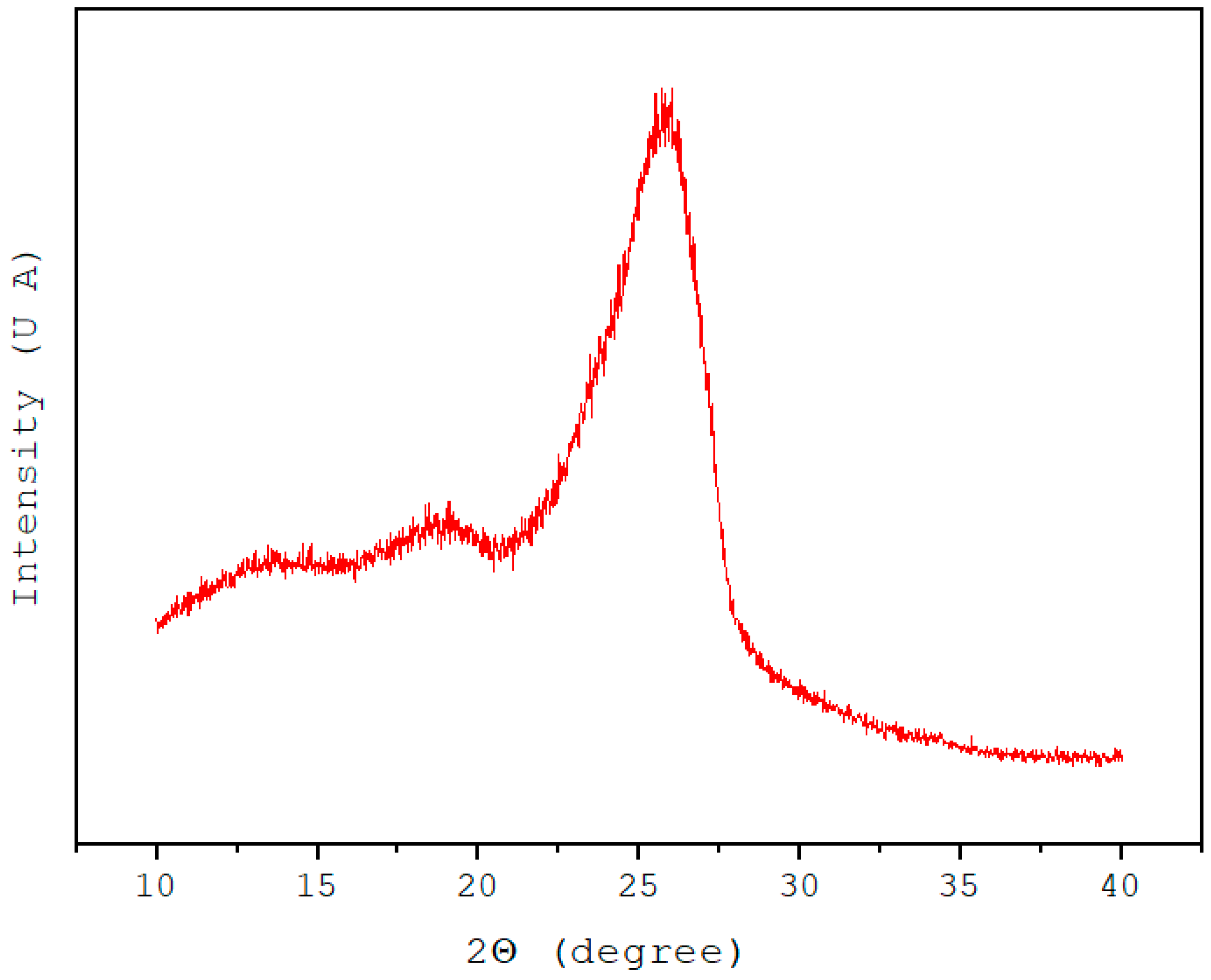
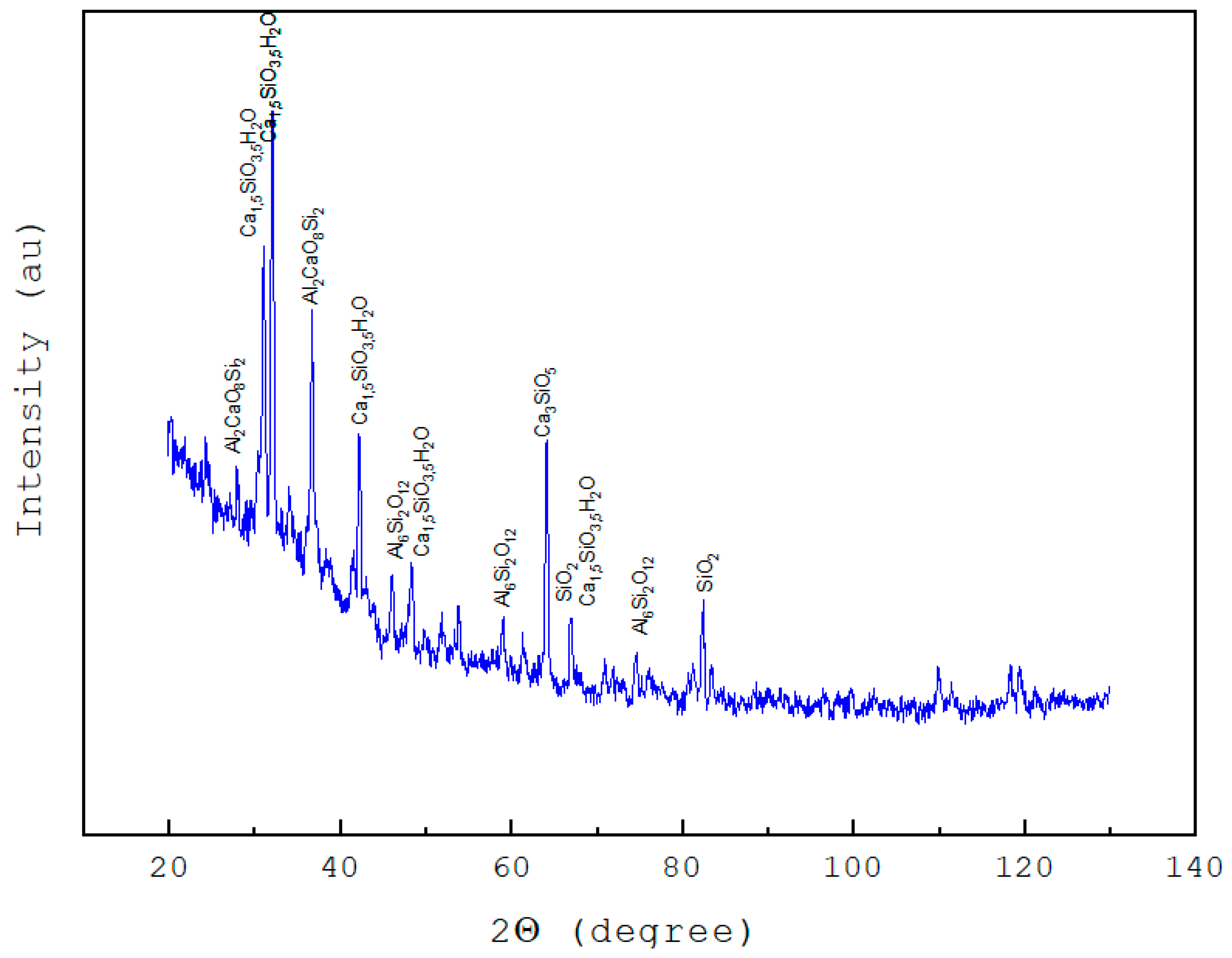


| Sample | Binder Material |
|---|---|
| Raw fiber | 80% BFS, 20% FA |
| The embedded fiber in concrete | 80% BFS, 20% and Guadua angustifolia fibers |
Disclaimer/Publisher’s Note: The statements, opinions and data contained in all publications are solely those of the individual author(s) and contributor(s) and not of MDPI and/or the editor(s). MDPI and/or the editor(s) disclaim responsibility for any injury to people or property resulting from any ideas, methods, instructions or products referred to in the content. |
© 2023 by the authors. Licensee MDPI, Basel, Switzerland. This article is an open access article distributed under the terms and conditions of the Creative Commons Attribution (CC BY) license (https://creativecommons.org/licenses/by/4.0/).
Share and Cite
Aperador, W.; Bautista-Ruiz, J.; Sánchez-Molina, J. Geopolymers Based on a Mixture of Steel Slag and Fly Ash, Activated with Rice Husks and Reinforced with Guadua angustifolia Fibers. Sustainability 2023, 15, 12404. https://doi.org/10.3390/su151612404
Aperador W, Bautista-Ruiz J, Sánchez-Molina J. Geopolymers Based on a Mixture of Steel Slag and Fly Ash, Activated with Rice Husks and Reinforced with Guadua angustifolia Fibers. Sustainability. 2023; 15(16):12404. https://doi.org/10.3390/su151612404
Chicago/Turabian StyleAperador, Willian, Jorge Bautista-Ruiz, and Jorge Sánchez-Molina. 2023. "Geopolymers Based on a Mixture of Steel Slag and Fly Ash, Activated with Rice Husks and Reinforced with Guadua angustifolia Fibers" Sustainability 15, no. 16: 12404. https://doi.org/10.3390/su151612404






